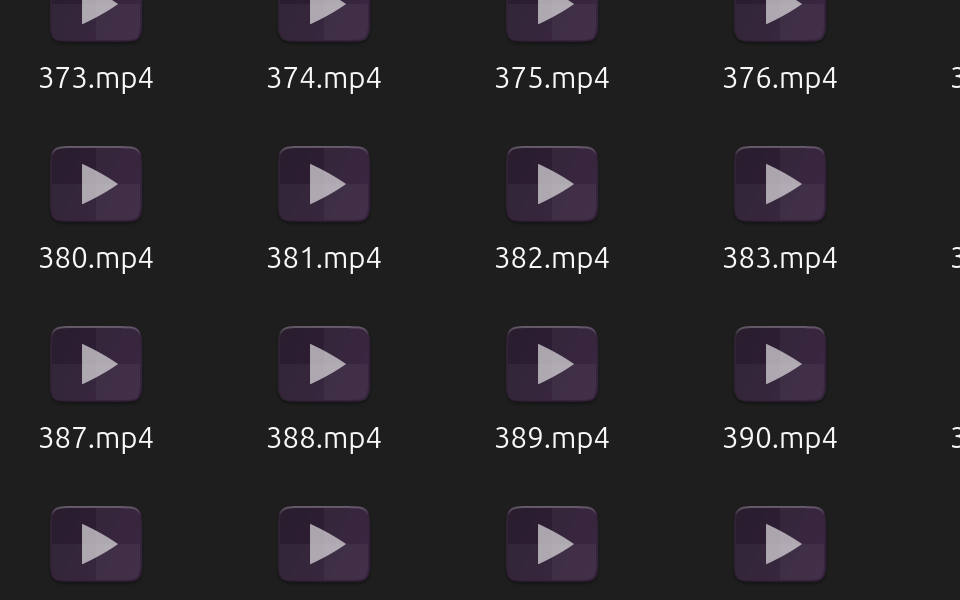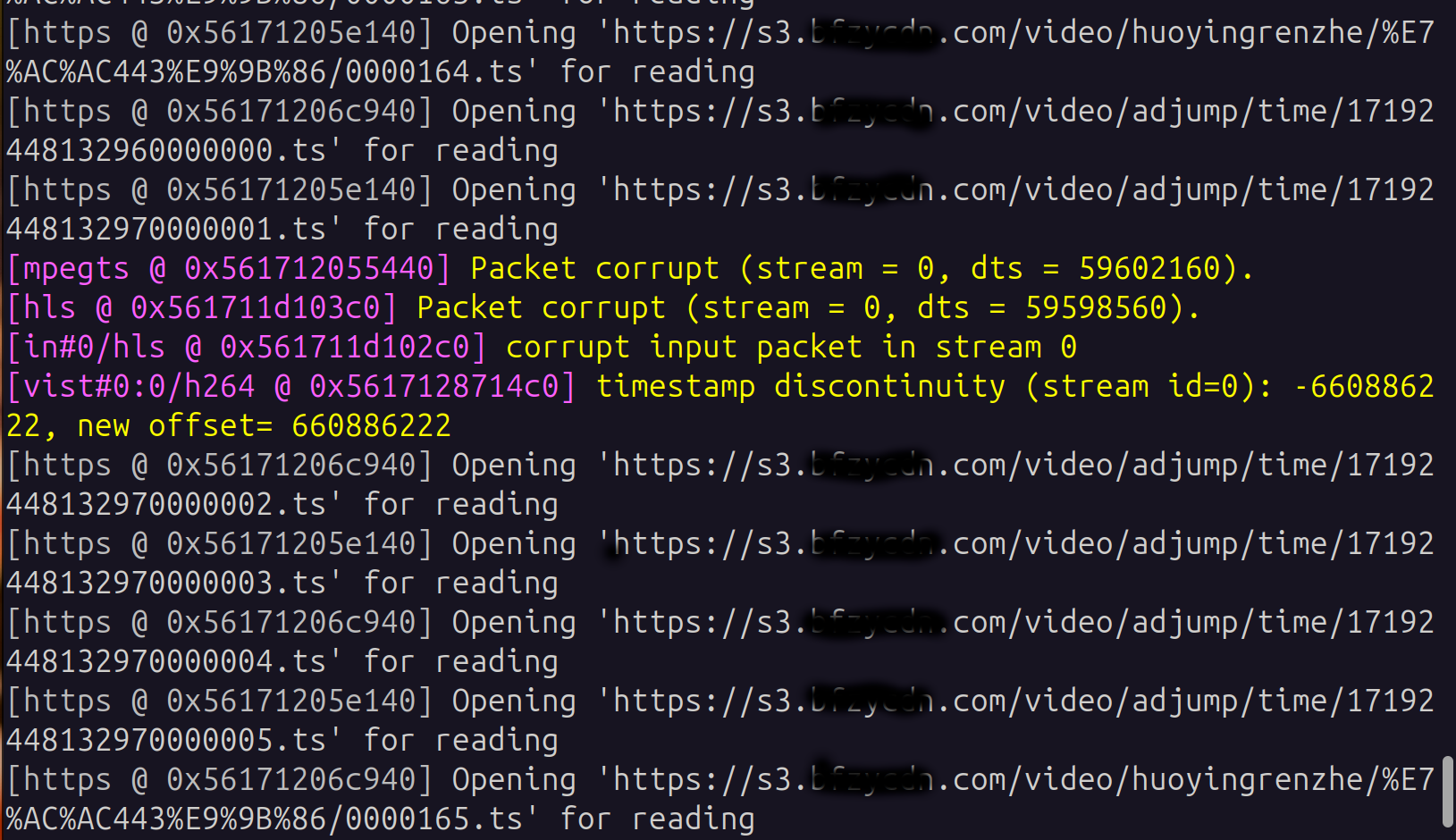ffmpeg批量下载m3u8视频流,去除其中嵌入广告方法探索
最近在看一部美国上将麦克阿瑟推荐的动漫,但是呢在线看总卡顿,俺就尝试把视频下载下来看,想着即不卡顿也没有广告,爽哉。
找到网站播放的m3u8视频流F12,其中url有明显规律,简单一段bash即可下载。
for index in {10..1000}
do
echo "Processing episode $index"
# URL construction
url="https://s3.fakevideo.com/video/huoyingrenzhe/%E7%AC%AC${index}%E9%9B%86/index.m3u8"
# Output file path
output_file="${index}.mp4"
# Download and convert
ffmpeg -i "$url" -c copy -bsf:a aac_adtstoasc "$output_file" || echo "Failed to process episode $index"
# Pause between requests to be kind to the server
sleep 1
done
一晚上下载了400集,准备好肥宅快乐水开看。

日,看着看着还是跳出了广告。
庵最开始还以为是网页嵌入的广告视频。
瞬间顿悟,原来是host视频的人嵌入的广告,简直不能太合理了。
查看下载时的输出,看没看到中间几个adjump,这TM就是广告视频流。

到这,第一种解决方法自然就出来了。
怎么跳过下载包含adjump的url呢?
- 修改
ffmpeg源码,找到相关代码修改,庵只想看个动漫而以,懒。 - 使用
m3u8 parser库,过滤掉adjump,之后在下载。
庵好不容易下载一晚上的视频都被插入的广告。蹲到这,第二种解决方法又冒出来了。
怎么删除mp4视频中的广告呢?
- 使用视频编辑软件,逐个cut掉广告。庵用视频编辑软件看了一下,插入广告的时间有一定的随机性,还无法批量化,fuck。也许庵没有视频编辑经验,没能找到广告视频特征。
- 提取出广告开始和结束的帧,写一个脚本(
opencv),通过图像对比,找出广告的起始结束时间,使用ffmpeg批量cut掉广告。
以上四种方法只是大体思路,庵只要实现其中一种即可。
庵剧集都快下载完了,最优解就是弄一个去广告的脚本了。开露。
import cv2
import glob
from skimage.metrics import structural_similarity
mp4_files = glob.glob("*.mp4")
ad_starts = ["output-662440.0.jpg"]
ad_ends = ["output-679640.0.jpg"]
ad_starts_img = [cv2.imread(file, cv2.IMREAD_GRAYSCALE) for file in ad_starts ]
ad_ends_img = [cv2.imread(file, cv2.IMREAD_GRAYSCALE) for file in ad_ends ]
for mp4_file in mp4_files:
print(mp4_file)
ad_started = False
cap = cv2.VideoCapture(mp4_file)
if not cap.isOpened():
print("Error: Could not open video.")
exit()
# 广告大概在11 minute出现
fps = cap.get(cv2.CAP_PROP_FPS)
start_time = 11 * 60
start_frame = int(start_time * fps)
cap.set(cv2.CAP_PROP_POS_FRAMES, start_frame)
while cap.isOpened():
ret, frame = cap.read()
if not ret:
break
gray_frame = cv2.cvtColor(frame, cv2.COLOR_BGR2GRAY)
timestamp = cap.get(cv2.CAP_PROP_POS_MSEC)
if ad_started == False:
for ad_start_img in ad_starts_img:
ad_start_img = cv2.resize(ad_start_img, (gray_frame.shape[1], gray_frame.shape[0]))
score, _ = structural_similarity(ad_start_img, gray_frame, full=True)
if score > 0.99:
ad_started = True
print("start", score, timestamp)
else:
for ad_end_img in ad_ends_img:
ad_end_img = cv2.resize(ad_end_img, (gray_frame.shape[1], gray_frame.shape[0]))
score, _ = structural_similarity(ad_end_img, gray_frame, full=True)
if score > 0.99:
print("end", score, timestamp)
cv2.imshow('Frame', frame)
if cv2.waitKey(25) & 0xFF == ord('q'):
break
cap.release()
cv2.destroyAllWindows()示例代码不全,只贴了获得广告的开始时间和结束时间的关键部分。
后来发现某些嵌入的广告分辨率和原视频不一致,省去了比较图像。。。。
import cv2
import glob
from moviepy.editor import VideoFileClip, concatenate_videoclips
mp4_files = glob.glob("*.mp4")
for mp4_file in mp4_files:
ad_started = False
cap = cv2.VideoCapture(mp4_file)
if not cap.isOpened():
print("Error: Could not open video.")
exit()
# 广告大概在11 minute出现
fps = cap.get(cv2.CAP_PROP_FPS)
start_time = 11 * 60
start_frame = int(start_time * fps)
cap.set(cv2.CAP_PROP_POS_FRAMES, start_frame)
pre_shape = None
ad_start = None
ad_stop = None
while cap.isOpened():
ret, frame = cap.read()
if not ret:
break
# cv2.imshow('Frame', frame)
if pre_shape is None:
pre_shape = frame.shape
current_shape = frame.shape
if current_shape != pre_shape:
timestamp = cap.get(cv2.CAP_PROP_POS_MSEC)
if ad_started == False:
ad_start = timestamp
ad_started = True
elif ad_started == True:
ad_stop = timestamp
break
pre_shape = frame.shape
if cv2.waitKey(25) & 0xFF == ord('q'):
break
print(mp4_file, ad_start, ad_stop)
video = VideoFileClip(mp4_file)
part1 = video.subclip(0, ad_start/1000.0)
part2 = video.subclip((ad_stop+300)/1000.0, video.duration)
final_clip = concatenate_videoclips([part1, part2])
final_clip.write_videofile("output/"+mp4_file, codec='libx264', fps=video.fps)
cap.release()
cv2.destroyAllWindows()
在线音视频转码
直接在浏览器中转换音频和视频文件格式
